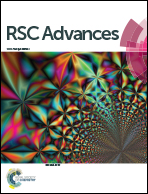Ultrafine MnO2 nanowires grown on RGO-coated carbon cloth as a binder-free and flexible supercapacitor electrode with high performance
Abstract
Reduced graphene oxide coated carbon cloth has been used as a substrate for the growth of ultrafine MnO2 nanowires (CC/RGO/MnO2), forming binder-free and flexible supercapacitor electrode materials. The experimental results indicate that a maximum area-specific capacitance of 506.8 mF cm−2 was gained from the CC/RGO/MnO2 electrode at the current density of 0.128 mA cm−2. Furthermore, the electrode exhibits excellent cycling stability (98.6% specific capacitance was still retained after 10 000 galvanostatic charge–discharge (GCD) tests when the current density was 1.28 mA cm−2). What's more, the area-specific capacitance of the CC/RGO/MnO2 electrode was hardly changed, when the electrode was operated under bending mechanical conditions. In addition, the charge storage performance and mechanism of the MnO2 nanostructures was discussed.



 Please wait while we load your content...
Please wait while we load your content...